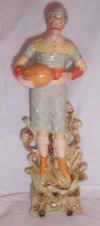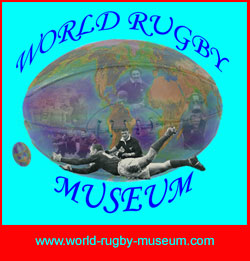|
Development of the Rugby Ball
|
|
|
|
|
|
Development of the Rugby Ball
|
|
|
|
|
|
The town of Rugby, Warwickshire and in
particular two businesses close to the school, Gilbert's and Lindon are chiefly
responsible for the development of the rugby ball as we know it today.
Originally a pig's bladder was used for football in the public schools of England, but unfortunately for the pigs, the life span of a sporting bladder was short and they needed to be replaced regularly. The solution to the problem was for the bladder to be covered with leather and local shoemaker's were called in to solve the problem. By 1800, leather casings surrounded the bladder, which is naturally oval in shape, to prolong the life of the ball. Prior to the 1840s the aforementioned William Gilbert and Richard Lindon, cobblers by trade of Rugby, were both supplying balls, boots and other equipment to the masters and boys of Rugby School. In the 1850s vulcanised rubber was invented by an American, Charles Goodyear. Richard Lindon applied this method to the manufacture of bladders for his footballs but failed to patent the process. Others soon caught on and by the 1880s there were several manufacturers of 'footballs' in England all using the same process. Lindon is also credited with inventing the adaptor with which to blow up the ball, previously the stem of a clay pipe which was attached to the bladder was used. His wife had contracted a lung disease thought to have come from years of blowing up the pig's bladders with the stems, out of necessity a new method was born. The first mention of standard dimensions for a ball are in 1892. The RFU required that they were to measure 25.5 - 26 inches in width circumference and 30 - 31 inches in length circumference. In 1931 the dimensions were changed to the shorter and much narrower ball that is used today.
|
|

|
New Zealand 1905 All Blacks Giant Postcard published by the Western Mail in 1905 (WRM 0596) |
| 1906 Springboks signed ball. A 'Zug' ball,
these balls were available for purchase in SA,
see the Perrins & Burke, Port Elizabeth advert, where you can buy
the 'Zug' for 15 shillings. This advert is dated 1910. The signatures of
the 1906 South African team adorn one panel of the ball although these
are now faded and only one or two are legible. This was the first South
African touring side, a tour in which the term 'Springboks' was coined. The
illustration of a signed ball is of the 1906 tourists as
illustrated in Piggot's book of the tour. (WRM-0357)
1906 Springboks Giant postcard published by the News of the World (WRM-0597) |
|


|
A cap from Rugby School dated 1886. Each school house had caps, the Maltese Cross belonged to the house called 'Hutchinson'. The inside of the cap has the matches in which the pupil (F Agnew) played embroidered onto patches which are then sewn inside. The matches which include Rugby v New College Oxford and Rugby v Old Haileyburians 1887 and the 'Sixth Match (Sixth form against the rest of the school)'. (WRM-0185)
|

|
French bisque rugby figure, circa 1890. |

|
Typical bladder, circa 1950s. (WRM-0128) |


|
New Zealand & South African rugby ball badges, circa 1956 |
|
|
|
|
|
CARDIFF ARMS PARK - THE LONGEST KICK |

|
|
1st February 1986 - Cardiff Arms Park The crowd thought him mad, the media ‘ambitious’ only one man was certain he could do it. 70 yards 8 ˝ inches (64.65 metres) was the distance of the penalty that Paul Thorburn kicked for Wales against Scotland in 1986 with this Mitre Multiplex ball. The longest successful kick at goal in the history of Welsh International Rugby. This was one of 5 penalty goals kicked by the Neath legend as Wales went on to defeat Scotland by 22 points to 15. (WRM-563) |
